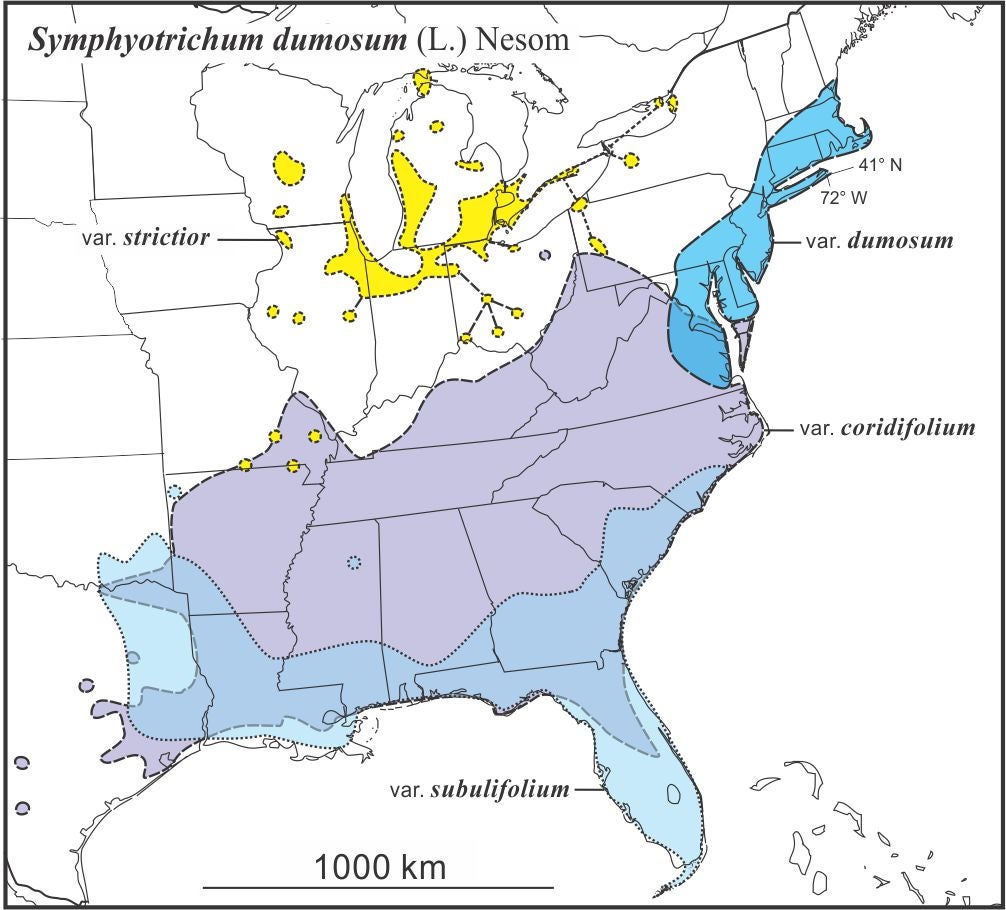Department of Biology
ESC 350
200 University Ave. W
Waterloo, Ontario, Canada N2L 3G1
Phone: (519) 888-4567 ext. 32569
Fax: (519) 746-0614
Bushy Aster
Symphyotrichum dumosum (L.) Nesom is native to eastern North America in usually open sunny habitats with dry to wet soils. Semple (2024) presented a review of the nomenclature and recognised four varieties. Semple, Horsburgh, and Hayter (2024) presented a multivariate morphometric analysis of S. dumosum and its varieties and S. simmondsii. Semple and Chmielewski (2024) presented the cytogeography of of S. dumosum and its varieties and S. simmondsii.

Typical var. dumosum is native from southern New England to eastern Virginia. Diploid (2n=16) and tetraploid (2n=36) var. dumosum usually have bluish to rarely pink or white rays and upper stem and branch leaves that are ascending to spreading or reflexed. The var. strictior (Torrey & A. Gray) Nesom is native to open wet soils near the southern Great Lakes in Ontario with scatter populations south in Ohio, western Pennsylvania and south to southeastern Missouri. Tetraploid (2n=36) var. strictior has white to rarely pinkish rays and leaves that a generally ascending to spreading. In Ontario, Phragmites has taken over habitats previously occupied by var. strictior in Ontario. The var. coridifolium (Michx.) Semple, Horsburgh & Hayter is the widely distributed central and southern variety of the species occurring from southwestern Pennsylvania and eastern Maryland south to central Florida and west southern Missouri and eastern Texas. Diploid (2n=16) and tetraploid (2n=36) var. coridifolium has rays that are usually bluish but sometimes pink to white and stem and branch leaves that vary from ascending to spreading or strongly reflexed downward on the same shoot. The var. subulifolium (Torrey & A. Gray) Nesom is the southern most variety occurring from southeastern North Carolina to South Florida and west on the coastal plain to southeastern Oklahoma and eastern Texas. Diploid (2n=16) and tetraploid (2n=36) var. subulifolium has bluish to white rays and stem and branch leaves that are nearly always ascending. Plants intermediate between var. coridifolium and var. subulifolium occur across the range of sympatry of the two varieties. In the multivariate study, var. dumosum and var. strictior were more similar to each other than to the two southern varieties, and var. coridifolium and var. subulifolium were more similar to each other than to the northern varieties. Numerous synomyms were listed under the four accepted varieties by Semple (2024). The octoploid (2n=64) Symphyotrichum simmondsii is a likely close relative but was found to be statistically distinct from S. dumosum by Semple et al. (2024).
Symphyotrichum dumosum var coridifolium, Semple & Chmielewski 6095 WAT, South Carolina
Symphyotrichum dumosum var. strictior, Semple 2961WAT, Long Point, Ontario
Symphyotrichum dumosum var subulifolium, Semple 11683 WAT, Liberty Co. Florida
Symphyotrichum dumosum varieties leaves and bracts
Symphyotrichum dumosum range from Semple (2024)
Semple, J.C. 2024. Varietal nomenclature of Symphyotrichum dumosum (Asteraceae: Astereae). Phytoneuron 2024-42: 1-5.
Semple, J.C., M. Horsburgh and M. Haggitt. 2024. A multivariate morphometric analysis of the Bushy Aster complex Symphyotrichum dumosum and S. simmondsii (Asteraceae: Astereae). Phytoneuron 2024-43: 1–15.
Semple, J.C., J.G. Chmielewski and M. Horsburgh. 2024. The cytogeography Symphyotrichum dumosum and S. simmondsii (Asteraceae: Astereae). Phytoneuron 2024-44: 1–8.
Last revised 6 June 2024 by J.C. Semple
© 2024 J.C. Semple, including all photographs unless otherwise indicated









